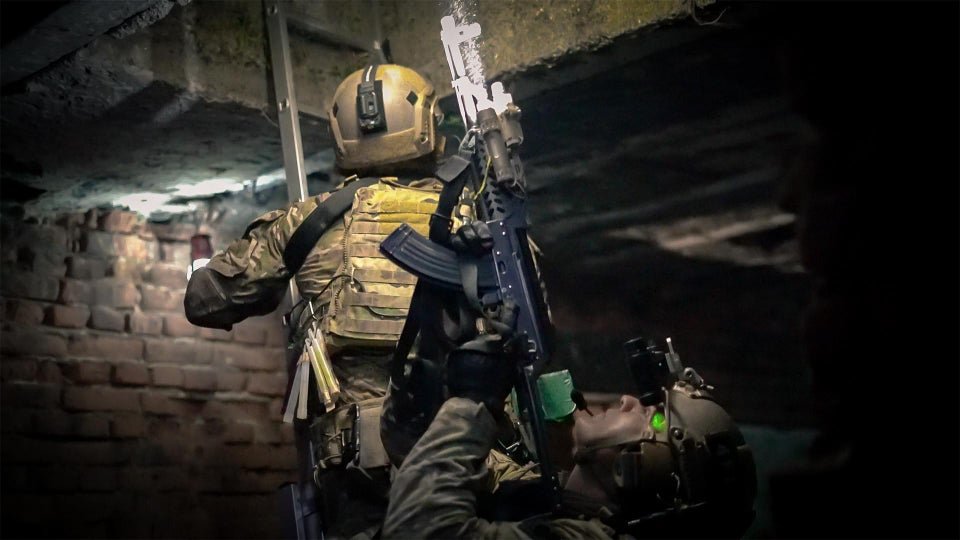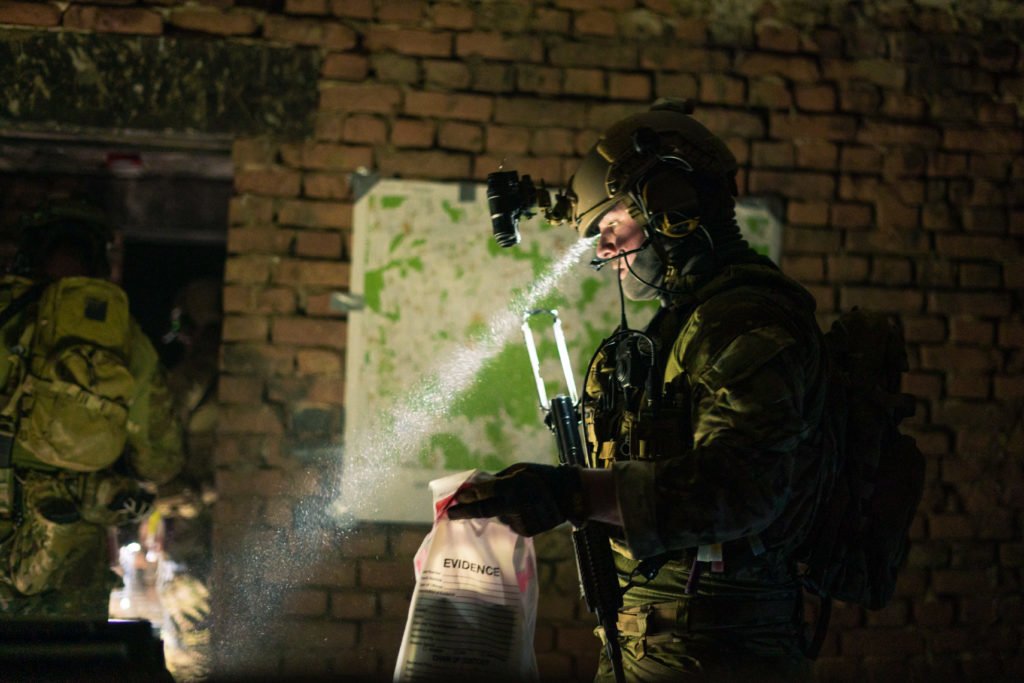Trojan Footprint: How U.S. and Allied Special Forces are Training in the Face of Russian Aggression

An American Special Forces soldier clears a building during Operation Trojan Footprint. Photo by Marty Skovlund Jr./Coffee or Die.
As the sun sank behind the hills just a few hours outside of Budapest, Hungary, a ragtag group of militiamen milled around a dilapidated building in a small clearing amid the Hungarian forest. With AK-47s slung on their shoulder, they played cards next to an open fire while American pop music emanated from a small AM/FM radio. Conversation was light; all spoke English but some with a distinct Eastern European accent.
A 30-minute drive away, an American Special Forces team and their North Macedonian Special Forces counterparts prepared for a night raid on the militia’s compound. The ODA’s team sergeant, the most senior enlisted leader on a Special Forces A-team, delivered his mission brief to the team. Like all special operators still working at the tactical level, he requested not to be named. “If at any time we get compromised while we’re moving in,” the team sergeant explained, “we’ll immediately assault building three and establish a foothold into the compound.”
Of course there is no war in Hungary, and this wasn’t a “real world” combat mission. These soldiers were a small part of a massive special operations exercise led by U.S. Special Operations Command – Europe called Operation Trojan Footprint. The annual exercise includes 10 nations and 1,400 special operators working in small teams throughout Hungary, Romania, and Bulgaria.
The locations of the exercise change every year, and 2019 was the first year that the Black Sea region was the focus of operations. But for the most part, the training takes place in the shadows. Unless you knew where to look, you’d have no idea that some of the world’s most elite operators were training in Europe’s backyard. And unlike the training American Special Forces do with allies in developing countries, most of these allied operators are combat experienced and have served side-by-side with their American counterparts in the Global War on Terror. On Sept. 5, 2019, a U.S. soldier and a Romanian soldier were killed in a car bomb attack in Kabul.

These European special operations units don’t require Americans to teach them how to shoot or conduct basic battle drills; the training in Trojan Footprint is built around the understanding that these nations’ operators are peers or near-peers. And in an era of ramped-up Russian aggression, the stakes are high.
Most of the world is familiar with the election tampering that the Russian government has been performing, but their efforts have not been purely digital. In 2018, a Russian mercenary force attacked an American outpost in Syria, T-72 tanks and all. According to a report by the New York Times, the mercenaries are trained at the Russian Defense Ministry’s bases, loosely coordinate with the Russian military in Syria, and have reportedly received awards from the Kremlin. Up to a dozen Russian citizens were killed in the unprovoked attack.
In 2008, Russia invaded the nation of Georgia and currently occupies up to 20 percent of the country. Some who live near the hasty border have literally gone to bed in Georgia and woken up in Russia. In 2014, Russia invaded Ukraine and now occupies 7 percent of the country. They are still in active combat. Ukraine is among the 10 nations participating in Operation Trojan Footprint, and Georgia has taken part in past years.

For the other former-Soviet-state nations, Russia’s recent actions are something like a canary in the coal mine. If it can happen to their neighbors, it can happen to them.
After the conclusion of the mission briefing, the team sergeant dismissed his men to prepare their equipment for the raid.
Back at the isolated compound, the militia soldiers prepared their defenses for the night. They rearranged getaway vehicles and made plans for who would “squirt” from the building to seek help if attacked. Although their role during this training event was as an opposition force, or simply OPFOR, the Americans in the force all hailed from the 19th and 20th National Guard Special Forces units, and most had combat experience to inform their tactics.
One of the OPFOR leaders in charge of the joint American-Hungarian militia explained that “just getting this kind of experience and being able to interact with our allies and get good training in” makes the exercise a worthwhile endeavor for him and his men. Indeed, tactical interoperability is one of the tenants of the exercise.

But there are strategic and policy-level benefits for military leaders and diplomats alike. The 2019 Trojan Footprint exercise is the first to incorporate the Regional Special Operations Component Command, which dramatically increases the ability of the nations in that region to effectively employ their Special Operations Forces in an efficient and timely manner. Modern warfare requires allies and the access that comes with them. Despite comments from U.S. President Donald Trump and other world leaders that seem to indicate a shift to isolationist policies, this exercise demonstrates the resolve of U.S. and NATO allies and their ability to defend the sovereignty of their fellow Alliance nations.
The cheesy pop music continued to float through the night sky, despite the militia putting out their fire and retreating into the building. An assault force of American and North Macedonian special operators were conducting their infil to the target, occasionally checking in over the radio. Although they couldn’t be seen, snipers were in place with eyes on the target. They had been there for hours. If anyone tried to run, they were unlikely to get very far.
After another hour or so of waiting, gunfire erupted. The militia’s muzzle flashes lit up their building, and the return volley from the assault force illuminated a nearby treeline. The firefight lasted maybe 30 seconds before dying down. Since it was a contested building, the assault force opted to use the “call out” technique.

“Call outs” became a regularly used tactic for special operations forces as far back as the 2007 to 2008 timeframe in Iraq. Rather than entering and clearing a building, the assault force employs a loudspeaker to urge the building’s inhabitants to walk out with their hands up, so they can be searched and questioned. Not only does this allow the enemy an opportunity to survive the encounter, it also reduces the chance of friendly casualties and non-combatant deaths. Additionally, it’s significantly easier to gain actionable intelligence from someone who is alive.
“Attention, residents of the building — this is the coalition forces,” the loudspeaker boomed. “We have shot and killed some of your people already, but no one else has to die. Surrender now and come out with your hands up.” The grim message of hope fell on deaf ears.

The loudspeaker message continued to urge the militiamen to lay down their arms and surrender, and a mashup of Celine Dion and Michael Jackson continued from the small radio still sitting in the window sill. The assault force then escalated with a gas attack. Of course this was “notional” due to it being training, but in a real-world call out, it’s not uncommon to escalate the incentive to surrender. This can include non-lethal means such as CS gas, depending on the mission and the target.
Another firefight broke out — it was much shorter this time — and then the loudspeaker started again. But now shadows started to move from the treeline, eventually forming silhouetted figures, rifles raised in anticipation of another volley of fire as they crept forward.
The observer-controller (OC — essentially a pseudo-referee during the training event) with a chemlight around his neck bluntly stated, “You’re dead. Sniper sees you.” One of the militia fighters that could be seen from a first-floor window quietly laid down.

Seconds later, the assault force entered the building and cleared through with bright-white lights affixed to the barrel of their modified AK-47 rifles. It was a small building, so it didn’t take long. Now the real work began: Sensitive Site Exploitation (SSE).
Special operations forces don’t pick their targets at random. There’s a method to the madness, and it’s called the F3EAD targeting methodology. This stands for Find, Fix, Finish, Exploit, Analyze, Disseminate. The cycle starts with finding the target, fixing him or her in time and space, then finishing the target. This could mean dropping a bomb in a kinetic strike or sending in a special operations unit to conduct a raid. But after “actions on” are complete and the building is secure, the operators must conduct SSE.

This is the “E” in F3EAD, and at the tactical level it means that the operators need to search every nook and cranny of the target building for usable intelligence. It’s not the most glamorous aspect of special operations, but it’s a vital cog in the machine SOF uses to dismantle enemy networks. This methodology was used with great effect in both Iraq and Afghanistan, ultimately leading to the deaths of infamous terrorists like Abu Musab al-Zarqawi and Usama Bin Laden.
After the assault force exploits the target, they’ll take what they found back to be analyzed. That analysis will then be disseminated out to the force to start the cycle all over again. It’s high-level concepts like F3EAD that are so important to share and train with allied special operations forces during an exercise like Trojan Footprint. The tactics, techniques, and procedures (TTPs) shared between allied nations are what will make the difference in real-world missions.

With SSE complete, the assault force made the call to exfil, thus signaling the conclusion of another successful training event. The joint American-North Macedonian assault force likely returned to base to complete an after action review (AAR) and prepare for the next day’s training.
Exercises such as Operation Trojan Footprint build and strengthen the relationships the United States has fostered with allies and partners in Europe while participating in combat and peacekeeping missions around the world. In a time when the presence of American service members is increasingly scrutinized, there is no substitute for a forward presence in Europe in the face of near-peer adversaries to the east.


Marty Skovlund Jr. was the executive editor of Coffee or Die. As a journalist, Marty has covered the Standing Rock protest in North Dakota, embedded with American special operation forces in Afghanistan, and broken stories about the first females to make it through infantry training and Ranger selection. He has also published two books, appeared as a co-host on History Channel’s JFK Declassified, and produced multiple award-winning independent films.
BRCC and Bad Moon Print Press team up for an exclusive, limited-edition T-shirt design!
BRCC partners with Team Room Design for an exclusive T-shirt release!
Thirty Seconds Out has partnered with BRCC for an exclusive shirt design invoking the God of Winter.
Lucas O'Hara of Grizzly Forge has teamed up with BRCC for a badass, exclusive Shirt Club T-shirt design featuring his most popular knife and tiomahawk.
Coffee or Die sits down with one of the graphic designers behind Black Rifle Coffee's signature look and vibe.
Biden will award the Medal of Honor to a Vietnam War Army helicopter pilot who risked his life to save a reconnaissance team from almost certain death.
Ever wonder how much Jack Mandaville would f*ck sh*t up if he went back in time? The American Revolution didn't even see him coming.
A nearly 200-year-old West Point time capsule that at first appeared to yield little more than dust contains hidden treasure, the US Military Academy said.












